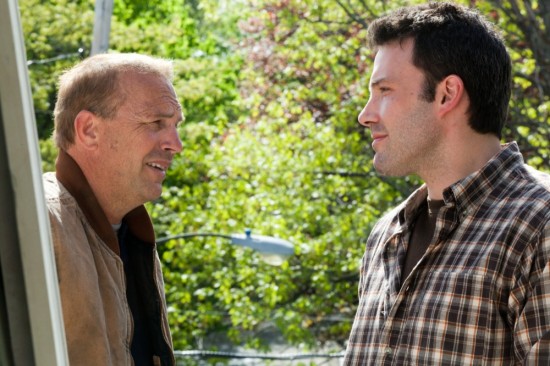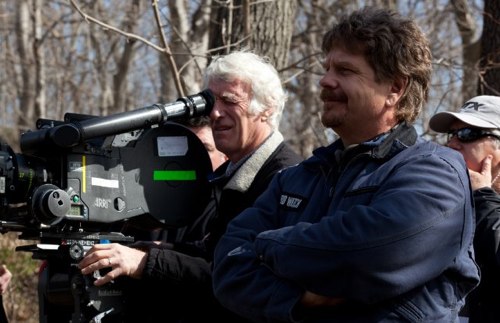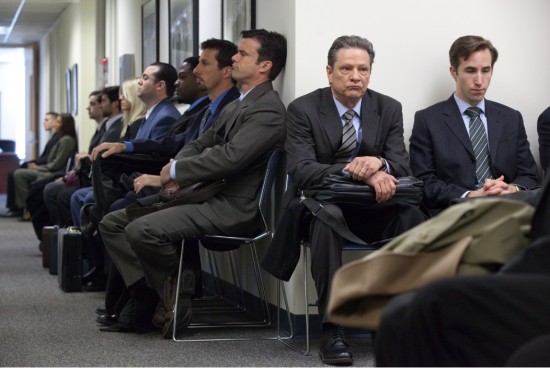
John Wells has been in the entertainment business longer than most, producing critically-acclaimed television (ER) and film (One Hour Photo, Far From Heaven) for over two decades. His first feature, The Company Men, was one of the first films to make waves at Sundance 2010, picked up by The Weinstein Company, and is finally seeing a limited release this Friday.
TFS talked to the filmmaker about the long road traveled to the film’s release, the current struggles of making independent films in today’s economic climate, the pleasure of working with master cinematographer Roger Deakins and never assuming you’ll eat out for lunch.
TFS: It’s been a year since Sundance. How’s the ride been?
John Wells: It’s been interesting, you know, the Weinstein’s picked it up although we negotiated for about two or three months. And then they wanted us to test the film again which I did and when I tested it I realized I wanted to cut about 10 or 12 minutes out of it. So they were kind enough to let me open the room back up and we did that and we did European festivals over the summer time, which was a load of fun. And then we were going to open in the fall but then The Town started to take off so everyone wanted to wait around until Ben [Affleck] had some time to promote because he was off doing the Terrence Malick film.
Weinstein pushed it back a couple of times. It had that December 10th release and then a couple of days before they bumped it to January 21st. Was it because of Ben that that happened?
The first one was because of Ben. The second one was because we were just going to open small and kind of try and widen out during December, but both Black Swan and The King’s Speech and particularly True Grit opened better than anybody thought. When we started to look at the theaters that were going to be available, we didn’t really have the theaters that we wanted. So we just did the qualifying week in New York – one theater in New York, one theater in Los Angeles – and gathered up some very good reviews, which was great, and we’re going to use those to help us open it now when we have the kind of screens we wanted to try and get.
It’s been 10 years since you wrote the first draft of this. What’s changed over the last decade?
Well, the script is very different. The first draft I wrote was inspired by – it’s not his story – but it was inspired by something that happened to my brother-in-law. He started to tell me the experiences he was having looking for a new job after he had lost his job after a big round of corporate downsizing. And I did a lot of research then and I really wrote a piece that was really about a central character: the character that ended up being Ben’s character in the final film.
And when I finished I wasn’t, I don’t know, I wasn’t quite satisfied with it. I had written it for Warner Bros. and sort of put it aside and then, a few years later in 2007, my researcher at the time, who had worked with me on the first one, said ‘you know I think this is heating up, you might want to go back and take a look at it’ and I did and went back and did a couple hundred more interviews, talked to some people who were going through it and re-wrote for what was happening at the beginning of the TARP mess and everything that was happening with the Bush Administration. And that’s really what became the film. So the film’s probably 60, 65 percent changed to those economic circumstances. Other characters became central to it who hadn’t been there before. So I had been working on it and taking notes on it for that long but it really came together in 2007, 2008.
You have this interesting relationship between Kevin Costner’s blue collar worker, he owns a small business, and then Ben Affleck’s is a victim of big business. What was the inspiration for that dynamic?
Well, I grew up doing a lot of carpentry work. I worked as a carpenter and then when I was first pursuing my career as a writer I was working as a carpenter all day long, building houses and then writing in the evenings. So I had spent a lot of time around carpenters and construction people and was very impressed that there was a different ethos about how they took care of each other; that wasn’t what was happening in the corporate world from what I was hearing from people.
What I was trying to get at in this film, in large part beyond what was going on in the business world, was this notion that when you get into these kind of difficulties what really pulls you through are your families and friends and the community you have around you. And in the blue-collar world that I worked in that community really took care of itself and in the business community it really didn’t. So I was kind of trying to show the contrast between those two worlds and the moral obligations felt in the construction world that I didn’t see at all in the corporate world.
The Dow’s up now and we seem to be on our way out of the woods, maybe. Film has survived, if just barely. Independent film, however, continues to lose solid distributors and investors and studios. What changes need to be made in order to keep up with the times? Particularly in independent film.
Well, unfortunately, independent film has to continue to lower the expectations of what kind of money is going to be available to make it. And, personally, I feel the major studios are being short-sided in not supporting the up-and-coming filmmakers and independent films. So much of the talent base eventually grows out of that world. And if it’s not supported I don’t know where that whole next level of people are going to be, doing the films that studios want you to do. So my belief isn’t so much that it’s a workplace issue. People are willing to work hard and work for not a whole lot of money to make things they feel really passionately about. At the same time, the companies need to make a commitment to supporting the development of other artists and that mostly comes out of the independent film world.
 This might be more of a question for Roger Deakins, but I have to ask. There are many frames within frames in the film, as though each frame is capturing a moment in time. How did you and Roger go about constructing these shots?
This might be more of a question for Roger Deakins, but I have to ask. There are many frames within frames in the film, as though each frame is capturing a moment in time. How did you and Roger go about constructing these shots?
We spent a lot of time talking about it. I was very fortunate to get Roger to do it and very fortunate that Roger could give me five weeks during pre-production. We had visited all of the locations, most of them numerous times, and had very extensive conversations about what it would look like and what we wanted it to look like. We wanted to give an impression of the dignity with which these kind of people were trying to face what was going on in their lives and we thought that would be well-served by sort of more classical ways of framing an moving the camera. So it was a very specific conversation we had a lot.
You’ve directed television episodes before, but this was your first foray as a producer/director of a feature film. What was the biggest difference you learned between directing a television episode and a feature film?
Well the kind of television I have done, you know, the technical aspects of it, you’re shooting on film and you’re shooting a lot on locations, so all of those things were familiar to me. The difficult thing on this film was to get the cast together that we were very fortunate to get together. I didn’t have everyone all the time. And so Ben was the only person who was really there for the whole shoot. The shoot was 40 days, it was pretty tight, and I was struggling with trying to make the schedule. I had Kevin [Costner] for six days out of the 40 days, and Tommy [Lee Jones] for 17 and Chris [Cooper] for 13 or 14 and Maria [Bello] 10. So when the whole schedules came together there was only one way to shoot the movie and it made for a lot of really crazy days where you would never, in a more leisurely schedule, have shot it that way. So it was a real scramble every day. Much more so than I had done in television.
Little touches in the film, such as Bobby [Affleck] expecting to eat lunch out his first day working for Jack [Costner]-
That happened to me.
Where do these little gems come from?
That one came from me but the larger thing was research. I talk to a lot of people before I write anything. By email I talked to a couple thousand people. And either on the phone or in person I spoke to another couple hundred, and virtually everything in the film are bits and pieces of what I heard from people. Either bits of dialogue, things they say, particularly all of the business stuff, or anecdotes about what had happened to them in their job searches. Or there had been things that I had personally been through.
Yeah I managed to show up one day with a new pair of gloves and no lunch thinking we were going to go to Burger King or something. I didn’t have anything to eat and my hands were all torn up and a nice guy came up and gave me half a sandwich and an old pair of gloves to wear.
You’ve got Shameless on Showtime now. What’s next?
Shameless is almost done. That’s part of what I’ve been doing this year, between Sundance and the opening of the film. We’re almost done with that and hopefully we’ll get another year but we haven’t heard anything yet. But we don’t have another season yet. It’s been reported so I’m happy to tell you – and I think it’s going to work out – I’ve been working with Tracy Letts on his screenplay of August: Osage County, his Pulitzer Prize-winning play. We’re going to do it hopefully in the fall with Meryl Streep and Julia Roberts.
How much would the success of Killer Joe [another Tracy Letts film adaptation starring Matthew McConaughey] help your film?
This is a film that The Weinstein Company owns in large part because I believe they were also involved in the production of the play on Broadway. And I think their interest is largely in the quality of cast that’s likely wanted to be involved this kind of material rather than previous, wonderful work that Tracy’s done.
The Company Men expands on Friday, January 21st.

